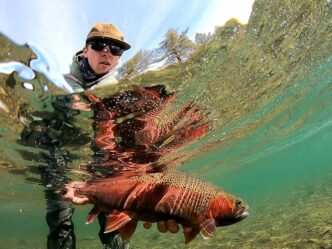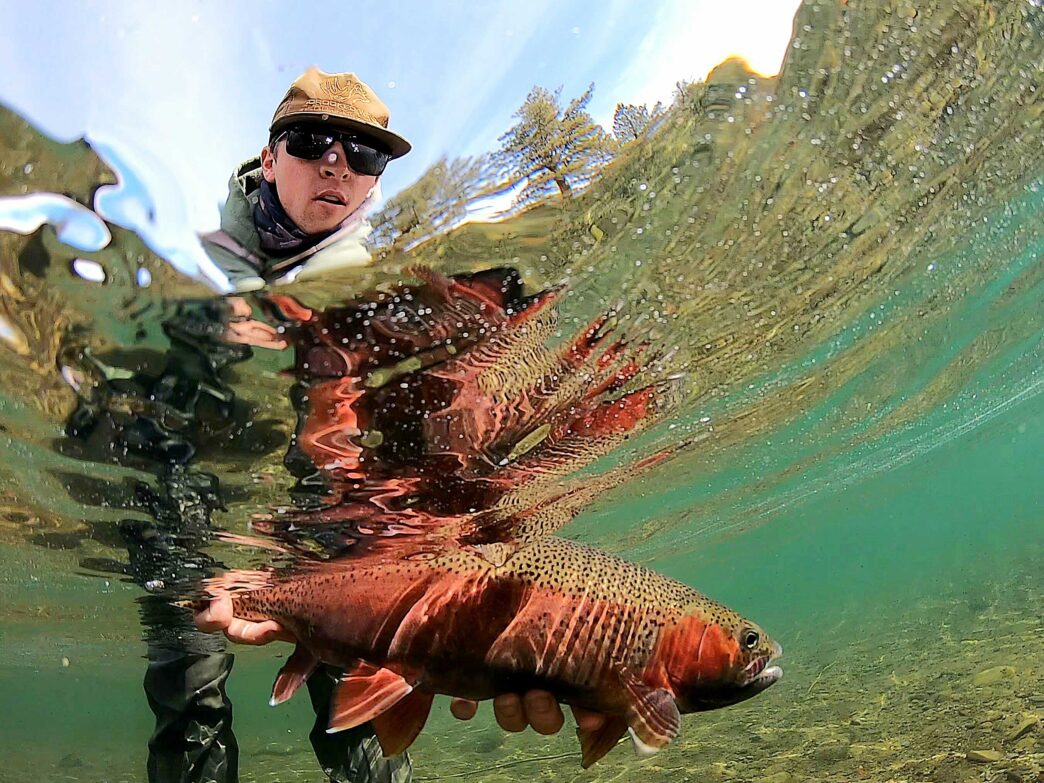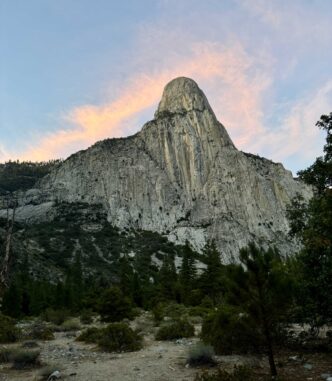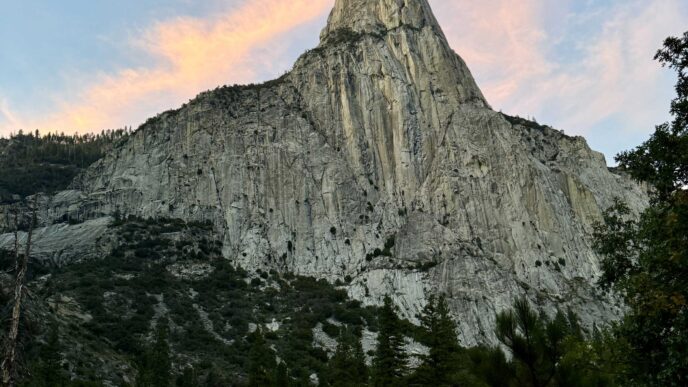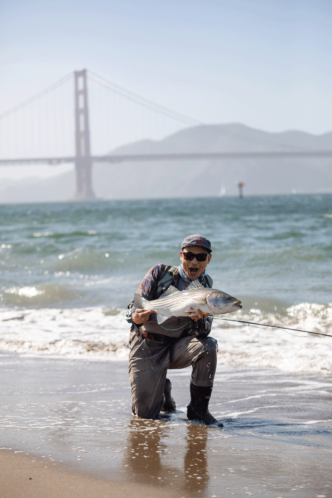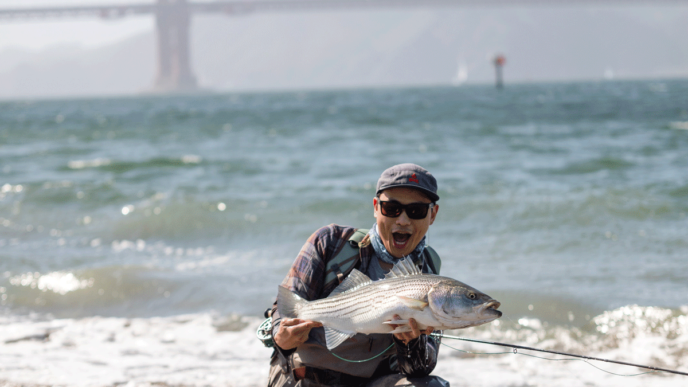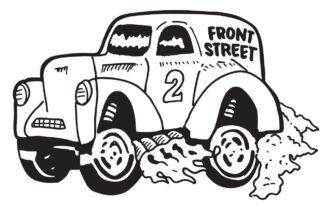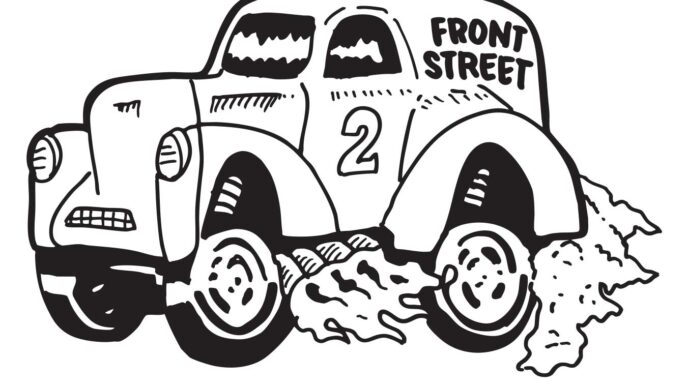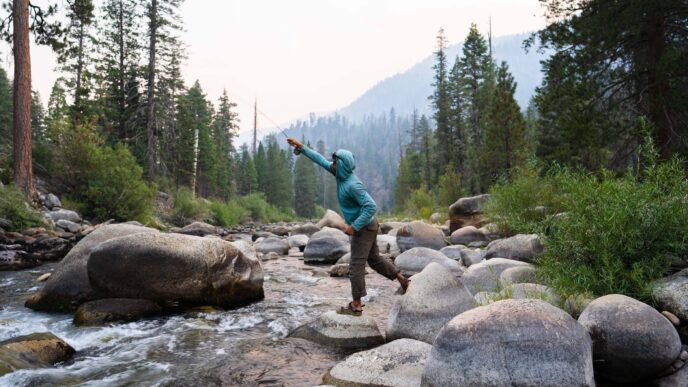“How many of you have fished the Truckee before?”
Typically, this is where most hands go up as I start my presentations. Followed by, “Leave your hand up if you consistently do well on the Truckee.” This is when 90 percent of the hands slowly and awkwardly ascend back to their laps, as attendees look at their neighbors, hoping they aren’t alone.
But why? Why do anglers have such a hard time fishing the Truckee? Well, I can’t possibly know everyone’s reason, but I do know one thing. In the last twenty years, my clients have had a blast dissecting, learning and succeeding on one of the best wild trout rivers in the West.
Here’s a sneak peek at the Truckee, from a guide’s perspective.
LET’S START FROM THE TOP, LITERALLY
There are more than 60 tributaries, big and small, that fill Lake Tahoe with some of the most beautiful, crystal-clear “Keep Tahoe Blue” water on the planet. Mark Twain may have put it best when he said, “I thought it must surely be the fairest picture the whole earth affords.”
Lake Tahoe and its tributaries, including its largest—the Upper Truckee River—wind their way along the Truckee River, the lake’s only outlet, flowing northeast past Reno and finally north to Pyramid Lake. Home to the Lahontan cutthroat trout—once dubbed the “salmon trout” by Native Americans—it was, and still is, North America’s largest trout and the world’s largest cutthroat. Endless stories tell of “trout the size of king salmon spawning in the Truckee River—so big, so plentiful you could walk across their backs.”
The largest recorded fish caught on rod and reel was landed in 1925, weighing an astonishing 41 pounds. A friend once told me about an old newspaper clipping describing fish exceeding 50 to 60 pounds landed in commercial nets. There have even been whispers of fisheries biologists discovering bone fragments from fish believed to have weighed over 70 pounds. True or not, the monstrous size of these giant Lahontan cutthroat trout is undeniable.
Today, Truckee River fish average 10 to 16 inches in length and, with few exceptions, are primarily wild rainbows and browns. However, it’s the 20- to 28-inch fish that have drawn the attention of serious—or lucky—anglers from around the country.
And for the angler looking to complete the “Truckee Slam,” we also have native mountain whitefish.
HISTORIC DOWNTOWN ‘TRO-KAY’
In the mid-1800s, a local Paiute chief was responsible for helping thousands of travelers ascend the Sierra peaks on their way from Nevada west to the lush Central Valley of California.
The chief’s name was ‘Tro-Kay’. Over time, settlers to the area would call him ‘Truckee’ using their own standards of dialect for the times.
The town of Truckee has quite the storied past.
Most notably, the world would recognize Truckee through its association with the historic tale of the ill-fated Donner Party in 1846, one of the most polarizing, tragic, and heroic stories found throughout American folklore.
Thankfully, Truckee’s story would soon make a turn for the better.
Many considered its railroad the biggest engineering feat of the 19th century. Once thought impossible, the East and West were now connected. This would forever shape the history of not just Truckee but also the iconic Lake Tahoe, altering the course of the American West Coast as we know it today.
Once the railroad was completed, Truckee’s history would change forever. Never-ending trail cars set the stage for booming industries such as lumber, ice, and yes, even the motion picture industry through the early 1900s.
Because much of the West was flooded with lumber mills popping up every few years, it was ice harvesting that really put Truckee on the map. In the 1880s tributaries to the Truckee River were dammed, “ice ponds” and “ice houses” were built, and before you knew it, Truckee train cars were shipping ice all over the western states. Ice harvesting was a profitable business in Truckee for a short time, with the Boca Mill and Ice Company the first to establish itself. Cooling the nearby mines, providing Sacramento and San Francisco’s hotels and bars with pure “Mountain Ice,” and preserving California’s produce for its trek across the country kept demand for ice high.
Not coincidentally, right next door to the Boca Mill and Ice Company was Truckee’s newest economic force, the Boca Brewing Company. Located on the Truckee River about seven miles downstream from town, the brewery produced California’s first-ever lager in 1876. This was one of the early drivers of tourism to the town of Truckee. Producing at its peak up to 30 thousand barrels a year, Boca Brewing Co. beer was shipped all over the country and was even featured at the 1887 World’s Fair.
Today, one of the snowiest cities in the country is best known for its outdoor recreation and lucrative tourism industry. Visitors from across the world flock here, filling hotels and Airbnbs each winter and summer and fully taking advantage of the endless outdoor opportunities it has to offer.
Most notably…fly fishing.
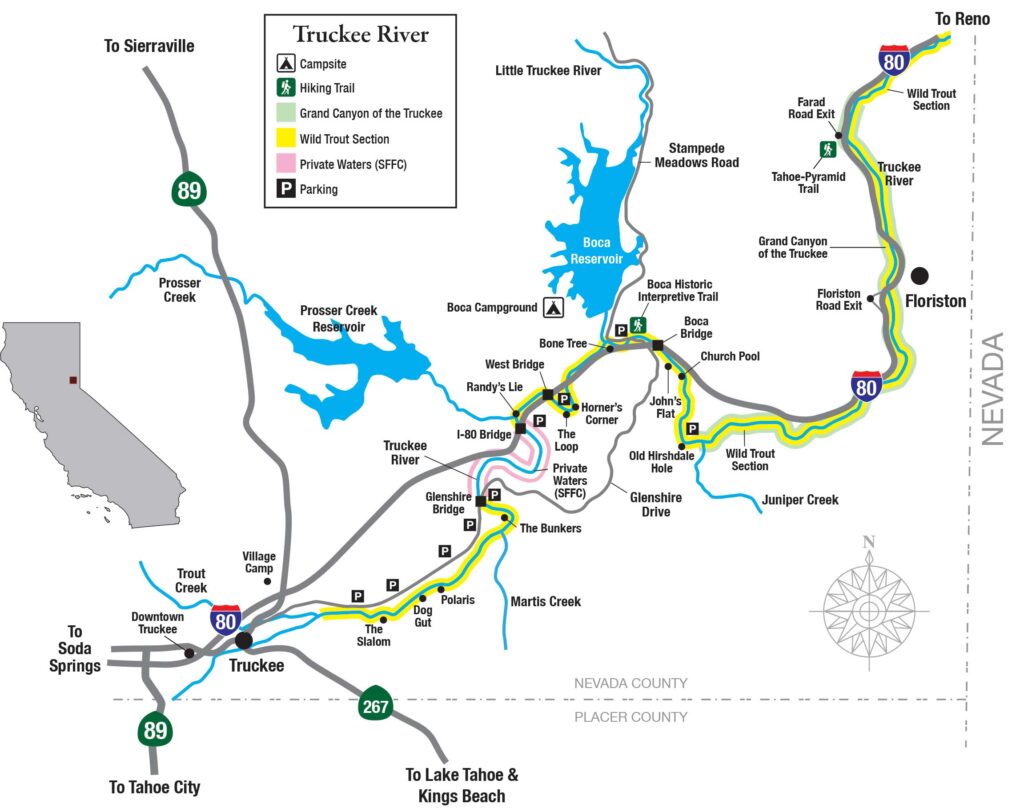
LAKE TAHOE TO TROUT CREEK
The “Upper,” or “89 stretch” of the Truckee River, as it’s known to local anglers, follows the highway from Tahoe City to downtown Truckee.
It’s known for its easy access and plentiful fishing opportunities. There are decent populations of brown and rainbow trout throughout this area (on good water years), mostly smaller in size with the occasional trophy being landed each year. Over 15 years ago, this area was stocked by the California Department of Fish and Wildlife with rainbows and some cutthroat. Although there have been some rumors of private stocking from time to time, today this stretch of river is home to 99 percent wild trout.
Skiers and snowboarders take note—if you’re looking to sneak in some casts before or after making a few turns, this is your zone. With this stretch passing directly in front of the two resorts that make up Palisades Tahoe, you can make it a cast-and-shred day.
TROUT CREEK TO PROSSER CREEK
We’re now getting into the first stretch of water that has put the Truckee River on the angling map. This section and its large wild trout have made the Truckee famous. From downtown to the stateline is where you start to run into larger fish. Don’t get me wrong, they don’t come easy. Appropriately nicknamed the “Trickee” or the “Toughee,” the Truckee doesn’t give up her secrets easily.
This section of the river can be accessed from Glenshire Drive as you head east out of town. It has countless dirt parking lots, making access easier compared to other sections of the river. This stretch ends at the well-known Glenshire Bridge parking lot. While fishing here can be exceptional, it may be one of the most heavily fished-from parking lots in the state. Consider yourself warned!
From Glenshire Bridge downstream for about three miles to the next Interstate 80 bridge is the historic San Francisco Fly Casting Club. Established in the late 1800s, it is one of the oldest fly-fishing clubs in the country.
In my twenty years of guiding the Truckee, I have been fortunate to receive several invitations from the club to host outings with non-profits such as Cast Hope, High Fives, and Truckee Trout Unlimited. It is a special place that continues to uphold the fly-fishing traditions of yesteryear.
The club section is private and clearly marked with signage. It’s also the only section on the California side of the river that is stocked annually. Of course, the hatchery fish do move in and out of the private water, so it’s not uncommon for an angler to occasionally land a rainbow that is not wild.
Just below the club property is Prosser Creek.
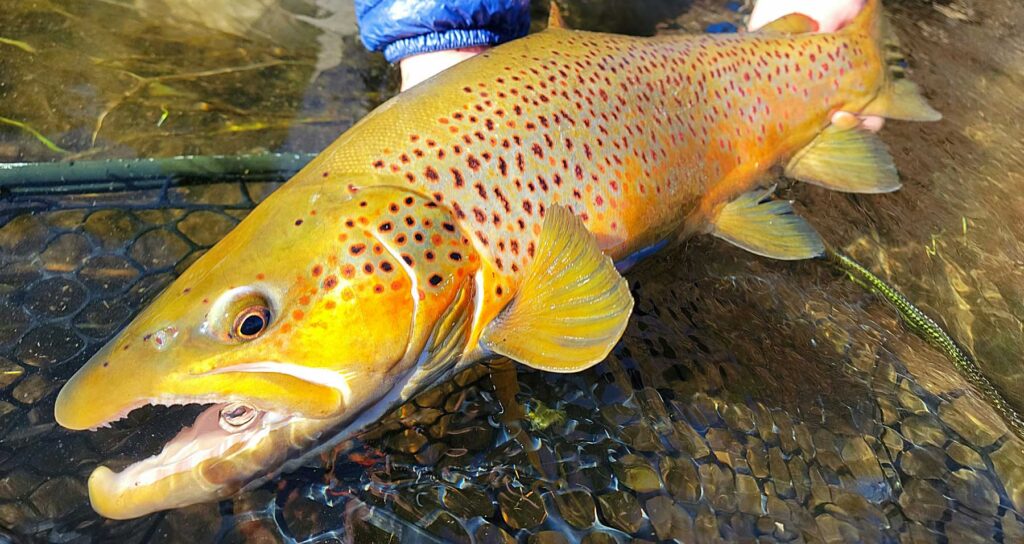
THE UPPER CANYON: PROSSER CREEK TO FLORISTON
This section can be accessed from dirt pull-offs along Interstate 80 or from the Boca/Hirschdale and Floriston exits.
This is where the river picks up flow from several different tributaries and really drops in elevation, especially below Hirschdale. These reasons alone may contribute to the lack of success for most “weekend warrior” anglers. It is a bit more challenging to find fish and get grabs compared to the upper sections of river. But I assure you, the fish are there.
On the topic of Hirschdale, there has been much coverage recently about river access at the Hirschdale exit. While the section of the river below Hirschdale Bridge was historically managed as public, it is, in fact, private.
I recommend checking out Truckee River Public Waters on social media to stay in the loop about access updates. This non-profit organization was recently formed by local stakeholders and anglers to improve access to the Truckee and keep the public informed about what’s legal and what isn’t. Also, be sure to read “The California Angler’s Bill of Rights” in our Winter 2025 issue.
THE LOWER CANYON: FLORISTON TO THE NEVADA BORDER
Like the section above, you can access the river through two exits, Floriston and Farad, and countless dirt pull-offs on Interstate 80.
Although the river does level out a bit, it’s quite a bit bigger than the upper river with some fast whitewater sections. A wading staff is highly recommended for this part of the river. Be sure to have one with you. You never know when that “Truckee Baptism” could strike. This is true for the Upper Canyon as well. (See ‘The Art of Wading Well.’)
This section has a good mix of picture-perfect pocket water, long deep runs, and amazing views in what has been coined the Grand Canyon of the Truckee.
The Upper and Lower Canyon can be great if you’re willing to walk a good distance from the parking lots. With a little bit of know-how, you can easily get away from the crowds and get entire sections of the river all to yourself.
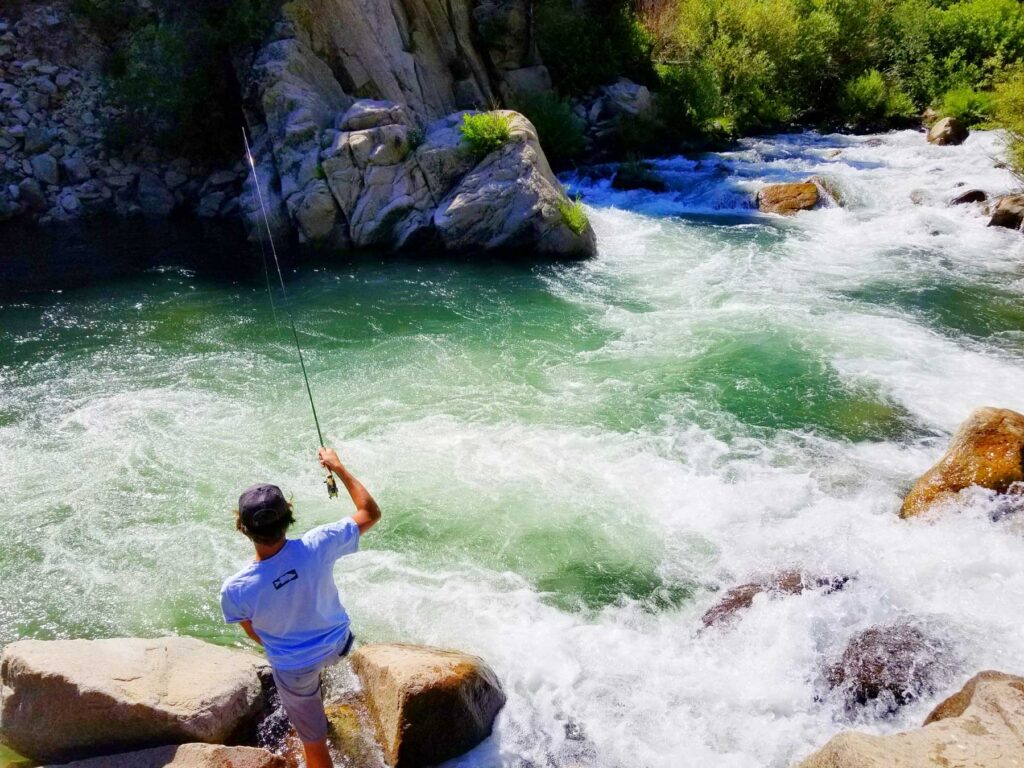
Matt’s Gear and Pro Tips for the Truckee
One of my favorite things about the Truckee is that you can catch fish just about any way you want. Want to try out your new anchor fly on a Euro rig? Do it. Looking for something new, and love the grab of streamer fishing? Give trout spey a try. On the Truckee, you can do it all. Here are some of my favorite set-ups.
Bobber/Indicator
Rod: Sage R8 Core 10-foot 5-weight
Line: RIO Elite Indicator, 6
Leader: Custom 5-foot, 12-pound butt section ending with a loose tippet ring, add tippet as conditions dictate.
Pro Tip: If you’re not snagging, you’re not bragging. Make sure you’re ticking bottom. Truckee fish love to feed horizontally more than vertically if there’s no hatch happening.
Tight Line/Euro
Rod: Sage ESN, 10.5-foot 3-weight OR 10-foot 4-weight
Line: RIO Technical Euro Nymph
Leader: Custom 45-foot, 12 or 15-pound, 4 feet of 3X with three tag-end, sliding sighters, add tippet and flies as conditions dictate.
Pro Tip: Most anglers don’t carry anchor flies heavy enough to get to the bottom in the Truckee’s deep runs. Don’t be afraid to add split shot above your anchor. But don’t add it below—drop shotting is illegal in California.
Dry Fly
Rod: Sage Classic R8 Core, 9-foot 4-weight.
Line: #4 RIO Gold XP
Leader: RIO Powerflex Trout, 9 feet of 4X, 5X Fluoroflex Strong tippet
Pro Tip: Delay your hook set. Make sure the head goes underwater before you set. Wait even longer for big flies like Skwalas and grasshoppers.
Streamer
Rod: Sage R8 Core, 9.5-foot 6-weight
Line: RIO #6 Streamer Tip
Leader: 4-5 feet of 12-pound Fluoroflex Strong tippet
Pro Tip: You don’t need to go crazy with your fly size. A standard 3-inch fly will catch just about everything in the river.
Hopper/Dropper
Rod: Sage R8 Core, 10-foot 4-weight
Line: #5 RIO Elite Indicator
Leader: RIO Powerflex Trout, 9 feet of 3X, 4X Fluoroflex Strong tippet
Pro Tip: This isn’t Montana. Fish as deep of a dropper as you want! Truckee fish will eat hoppers, but they will eat the dropper more consistently. Fish deep if you want more eats.
Trout Spey
Rod: Sage Trout Spey HD, 10-foot 9-inch 2-weight
Line/Head: #2 RIO Elite Trout Spey
Tip: RIO Trout Versileader Intermediate tip
Leader: RIO Powerflex Trout, 7.5 feet of 4X, 5X Fluoroflex Extra Strong tippet
Pro Tip: If you’re swinging deeper runs (+3 feet), keep changing the weight of your fly or your tip until you’re about a foot from the bottom.
FISHING THE SPRING AND SUMMER SEASONS
We’re currently moving into one of the best times to land that Truckee River trophy—springtime. River conditions can range from low and clear, to pre-run-off—flood stage, to post-run-off—high and clear. To say they can vary is an understatement.
Snowpack, water content in the snowpack, and the arrival of warmer temperatures all play a crucial role in determining run-off on the Truckee. If we play by the averages, peak flows are in April and May.
High water isn’t for the faint of heart and the conditions can be challenging. Here’s a few tips I’d keep in mind.
- Up your tippet size, 0X-3X is the norm for high water.
- Fish the edges. The fish will transition from fast water into slower water as flows rise.
- Fight fish hard, don’t let them get into fast water and head downstream or it’s game over.
- If you can learn to fish high, off-color conditions effectively, you have a good shot at landing the fish of your dreams.
Your fly selection for springtime on the Truckee should include:
- Midges (larvae, pupae, emergers, adults) size 18-22
- Baetis/BWO mayflies (nymphs, emergers, duns, spinners) size 16-20
- Eggs and worms, small to medium sizes
- Streamers (swung, stripped or dead drifted)
- Rubberlegs size 8-14
- Skwala stoneflies (nymphs, adult) size 10-12
- Attractors such as Jumbo Johns Hot Spots are worth a shot
There is typically a carpenter ant hatch that is very dependent on the weather and usually hits at the end of spring or early summer. It’s a fun one if you can catch it.
Summer is when most anglers flock to the river, and for good reason. By June, we typically begin to see our first consistent hatches of the year, water temperatures reach the mid-50s after runoff, and the fish take advantage of these optimal conditions.
Because of the plethora of bugs, summer can be the best time of year to fish dry flies. Although the Truckee isn’t famous for its outstanding dry fly fishing, this time of year the fish are looking up, and if you hit it just right it can be off the charts.
The following flies are good to have in your Truckee summer fly box:
- Pale Morning Dun mayflies, size 16
- Green Drake mayflies, size 10-12
- Several caddis options, size 12-18
- Yellow Sally stoneflies, size 14-16
- Golden Stoneflies size 8-12
- Nocturnal Stones, size 10-12
It’s also a good idea to carry an assortment of grasshopper patterns, size 8-14. Chubby Chernobyl’s natural-looking variations will work.
Finally, don’t forget the crayfish patterns. This unsung crustacean packs a mouthful of protein and may be one of the biggest factors for the Truckee kicking out some of the fattest fish in the west. Don’t leave home without them.
The wild Truckee browns and rainbows hold a special place in people’s hearts, and for good reason. I’m blessed to have some of the biggest, wild fish in the country in our backyard. But again, they don’t come easy. As they say, “If it were easy, everyone would do it.” But if you put your time in, you might just land the fish of a lifetime!
And hopefully you’ll keep your hand raised the next time you see me at your local fly club or show.
Matt and Lulana Heron are celebrating the 20th anniversary of Matt Heron Fly Fishing this spring. Their veteran team of guides and instructors run daily guide trips, classes, and is the home of Truckee Trout School with 101, 201, Youth, and Trout Spey options.
Truckee River | Quick Guide
Access Maps
The Truckee River Fishing Access Guide by Tahoe Angler Productions details access points and landmarks on waterproof and tear-resistant paper.
Lodging
There’s every type of lodging to choose from in Truckee. Here are a few of our favorites.
Gravity Haus: This modern yet rustic lodge caters to the eco-conscious adventurer. Amenities include hot tub, cruiser bikes, Callahan’s Lobby Bar, and Stella’s restaurant. Pet friendly.
Village Camp Truckee: Offers luxury RV sites and eco-adventure cabins that sleep four. Amenities include fitness center, bocce ball court, dog park and community spaces.
The Truckee Hotel: Located in the heart of historic downtown, this hotel will take you back in time. Constructed in 1873, it’s one of Truckee’s oldest properties. It’s been modernized but hasn’t lost its historic charm. The hotel serves a continental breakfast and Moody’s Bistro Bar & Beats occupies the ground floor.
Vacation Rentals: Go to VisitTruckeeTahoe.com for a comprehensive list of Truckee vacation rentals.
Camping
To book a campsite, go to Recreation.gov and search for Truckee where you’ll find these campgrounds: Prosser Ranch, Lakeside, Boca, Boca Rest, Boca Spring, Boyington Mill, Alpine Meadow, Granite Flat, Goose Meadow, Silver Creek.
Fly Shops
Trout Creek Outfitters has knowledgeable staff dedicated to fly fishing. They carry everything you need for a day on the water and has weekly fishing reports on their website.10115 Donner Pass Road, Truckee, 530-563-5119
Mountain Hardware and Sports also has knowledgeable staff and carries angling supplies and more. 11320 Donner Pass Road, 530-587-4844
Coffee Shops
Dark Horse Coffee Roasters, 10009 W River St. Opens at 7:00 a.m.
Drink Coffee Do Stuff, 10115 Donner Pass Rd., next to Trout Creek Outfitters. Opens at 7:00 a.m.
Wild Cherries Coffee House, 11429 Donner Pass Rd., Opens at 6:00 a.m.
Cool Things to Do
Donner Pass Summit Tunnels: Explore these now-abandoned tunnels built for the transcontinental railroad on the route the first wagon train entered California.
Old Boca Town Site: A short interpretive path shares the history of this forgotten town known for its ice harvesting.



